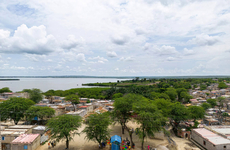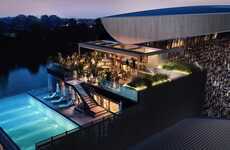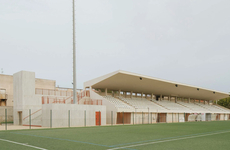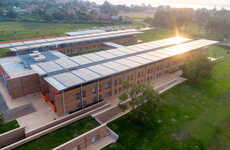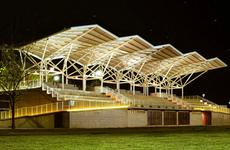
This Kenyan Stadium Gives Sustainable Architecture New Meaning
Jana Pijak — February 25, 2015 — Eco
References: waterbanks.org & modernfarmer
British architects Jane Harrison and David Turnbull are the creative minds behind this unique soccer stadium that takes sustainable architecture to new heights. The project was built in Kenya in 2014 and is equipped with a water-harvesting roof that is designed to collect up to 370 000 gallons of reusable rain water.
In addition to the architects' soccer stadium project, they have also built other Kenyan structures like a water-harvesting school that collects water for its students. Their projects provide water access to those who are without the crucial natural resource. Moreover, they inspire other cities to follow this sustainable architecture model.
In the case of Jane Harrison and David Turnbull's Waterbanks school, the structure "feeds water through a series of ceramic filters that purify it by removing pathogens." Their stadium is designed with the same model and aims to provide drinking water to hundreds of African households.
In addition to the architects' soccer stadium project, they have also built other Kenyan structures like a water-harvesting school that collects water for its students. Their projects provide water access to those who are without the crucial natural resource. Moreover, they inspire other cities to follow this sustainable architecture model.
In the case of Jane Harrison and David Turnbull's Waterbanks school, the structure "feeds water through a series of ceramic filters that purify it by removing pathogens." Their stadium is designed with the same model and aims to provide drinking water to hundreds of African households.
Trend Themes
1. Sustainable Architecture - Implementing sustainable design practices in building and infrastructure projects to reduce environmental impact and promote social responsibility.
2. Water-harvesting Technology - Developing and utilizing rainwater harvesting systems to provide a reliable source of potable water in water-scarce regions.
3. Innovative Sports Facilities - Designing sports venues that integrate with the environment and incorporate sustainable practices to enhance the user experience and reduce operating costs.
Industry Implications
1. Architecture - Incorporating sustainable design practices and innovative water management solutions in building and infrastructure projects to reduce environmental impact and enhance social impact.
2. Water Management - Developing and implementing water-harvesting technologies and systems to provide a reliable source of potable water to communities, public institutions, and businesses in water-scarce regions.
3. Sports and Entertainment - Integrating sustainable design and water management practices in the design and construction of sports facilities and entertainment venues to improve user experience, operating efficiency, and environmental sustainability.
2.6
Score
Popularity
Activity
Freshness




